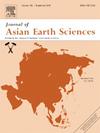风化玄武岩中钪和镓作为非常规资源
IF 2.7
3区 地球科学
Q2 GEOSCIENCES, MULTIDISCIPLINARY
引用次数: 0
摘要
钪(Sc)和镓(Ga)都是关键金属,由于它们在先进技术中的应用,需求量很大。然而,经济上可行的钪和镓矿床在世界上是稀缺的。现在迫切需要新的和替代资源来确保稳定的供应。中国东部新生代玄武岩体积庞大,构成了一条长达4000多公里的火山带。这些玄武岩具有洋岛玄武岩(OIB)的地球化学亲缘性,LREE相对于HREE的富集程度不同,平均Sc含量~ 19 ppm, Ga含量~ 21 ppm。本文报道了该火山带最南端雷琼地区玄武岩的富Sc和ga风化层。这些玄武岩在热带气候下强烈风化,风化剖面厚度从几米到30米不等。风化玄武岩的Sc和Ga浓度分别为19 ~ 50 ppm和18 ~ 47 ppm,比新鲜原岩高2倍。它们还不同程度地富集Nb (8.1 ~ 126 ppm)和Ti (1.3 ~ 4.9 wt%)。初步估计表明,在雷琼地区,Sc和Ga的最低储量分别为~ 30万吨。因此,玄武岩风化产物是潜在的重要Sc和Ga来源。虽然Sc和Ga的含量很低,但由于需求不断增加,开采容易且成本效益高,因此风化层中的Sc和Ga可能是这些元素的可行来源。如果与Nb和Ti结合,风化岩的值会更多。因此,风化玄武岩可能成为这些金属的潜在重要来源,最终有助于在未来维持可靠和稳定的Sc和Ga来源。这些非常规资源可能会在未来影响Sc和Ga的全球商业方面。本文章由计算机程序翻译,如有差异,请以英文原文为准。
Scandium and gallium in weathered basalts as unconventional resources
Being critical metals, both scandium (Sc) and gallium (Ga) are in high demand because of their usage in advanced technologies. Yet economically viable Sc and Ga deposits are scarce in the world. New and alternative resources are now urgently needed to ensure a stable supply. Cenozoic basalts in East China are voluminous and comprise a volcanic belt for more than 4000 km long. These basalts have geochemical affinities of ocean island basalts (OIB) with variably enriched LREE relative to HREE with average contents ∼ 19 ppm Sc, and ∼ 21 ppm Ga. We report here Sc- and Ga-enriched regolith of basalts in the Lei-Qiong region, the southernmost part of this volcanic belt. These basalts are strongly weathered under the tropical climate and regolith profiles range in thickness from a few meters to 30 m. The weathered basalts have Sc and Ga concentrations ranging from 19 to 50 ppm and 18 to 47 ppm, respectively, up to 2 times higher than the fresh protolith. They are also variably enriched in Nb (8.1 to 126 ppm) and Ti (1.3 to 4.9 wt%). Preliminary estimates suggest a minima of ∼ 0.3 million tonnes each of Sc and Ga in the Lei-Qiong region. Thus, the weathered products of basalts are potentially important sources of Sc and Ga. Although present in low concentrations, Sc and Ga of the regolith could be viable sources of these elements due to ever-increasing demand and easy and cost-efficient mining. If combined with Nb and Ti, the regoliths would have more even more values. Therefore, weathered basalts could become a potentially important source of these metals, which could ultimately contribute to the maintenance of a reliable and stable source of Sc and Ga in the future. Such unconventional resources may impact the global commercial aspects of Sc and Ga in the future.
求助全文
通过发布文献求助,成功后即可免费获取论文全文。
去求助
来源期刊

Journal of Asian Earth Sciences
地学-地球科学综合
CiteScore
5.90
自引率
10.00%
发文量
324
审稿时长
71 days
期刊介绍:
Journal of Asian Earth Sciences has an open access mirror journal Journal of Asian Earth Sciences: X, sharing the same aims and scope, editorial team, submission system and rigorous peer review.
The Journal of Asian Earth Sciences is an international interdisciplinary journal devoted to all aspects of research related to the solid Earth Sciences of Asia. The Journal publishes high quality, peer-reviewed scientific papers on the regional geology, tectonics, geochemistry and geophysics of Asia. It will be devoted primarily to research papers but short communications relating to new developments of broad interest, reviews and book reviews will also be included. Papers must have international appeal and should present work of more than local significance.
The scope includes deep processes of the Asian continent and its adjacent oceans; seismology and earthquakes; orogeny, magmatism, metamorphism and volcanism; growth, deformation and destruction of the Asian crust; crust-mantle interaction; evolution of life (early life, biostratigraphy, biogeography and mass-extinction); fluids, fluxes and reservoirs of mineral and energy resources; surface processes (weathering, erosion, transport and deposition of sediments) and resulting geomorphology; and the response of the Earth to global climate change as viewed within the Asian continent and surrounding oceans.
 求助内容:
求助内容: 应助结果提醒方式:
应助结果提醒方式:


